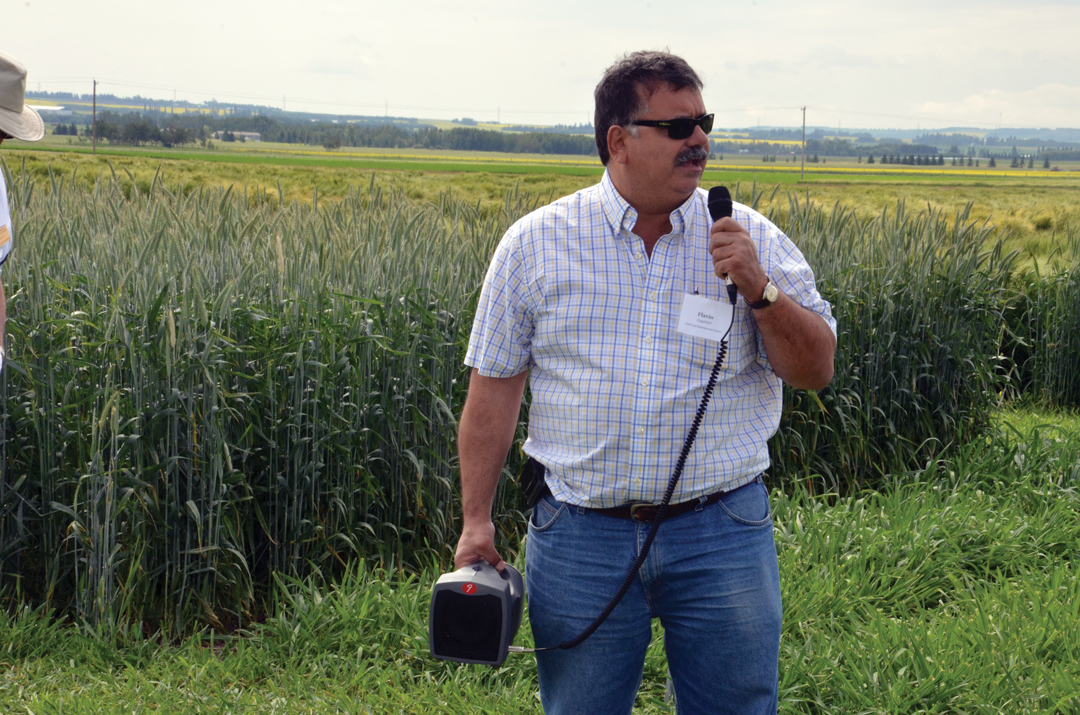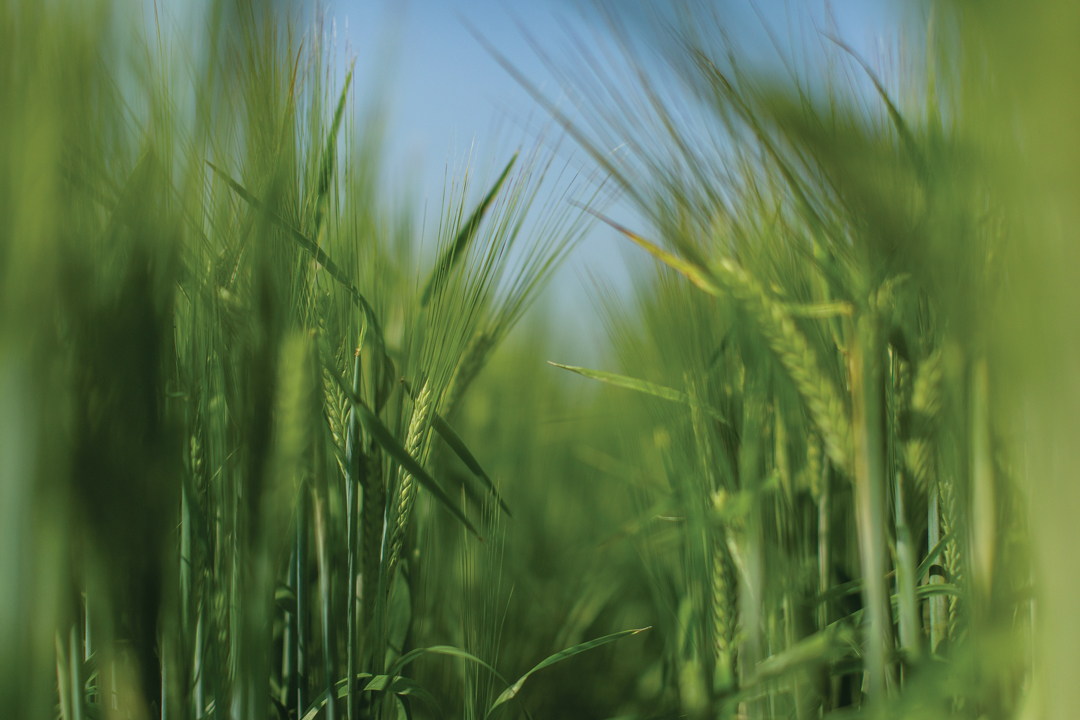BEATING THE BUSHELS-PER-ACRE BARRIER
INDUSTRY EXPERTS WEIGH IN ON BOOSTING BARLEY YIELD
BY GEOFF GEDDES • PHOTO BY TWITCHY FINGER PHOTOGRAPHY
Yield and quality are not everything to farmers; they’re the only things. In agriculture, success is measured by numbers, and the statistics for barley yield in recent years do not tell a winning tale. The average yield in Western Canada in 2017 was 64 bushels per acre, compared to 74 bu/ac and 65 bu/ac in 2016 and 2015 respectively. Not surprisingly, barley seeded acres and production in Western Canada also dropped over that period.
“Farmers are businesspeople, so their crop decisions are based on profit margins and return on investment,” said David Simbo, research program manager for Alberta Barley and the Alberta Wheat Commission. “In most years, malt barley sells for a higher price than feed barley, but the specifications to obtain malting barley are quite stringent.”
One of the main specifications for consideration for malt barley is that it should have no more than 12.5 per cent protein. Barley breeders tend to concentrate on breeding malting barley varieties. Lines that fail to meet the specifications for malting barley are bred as feed barley. In the process, selecting genes that contribute to good malt quality may be leaving out genes that contribute to higher yield.
“When growing barley for feed, farmers can put in more nitrogen, so feed barley tends to have higher yields than malt barley,” said Simbo. “Since most farmers opt to grow malt barley for the higher price, overall yield suffers.” As well, because barley tends to have higher rates of lodging compared to similar crops such as wheat, it’s more likely to present a challenge at harvest.
The fact that alcohol production is the main use for malt barley is also a factor hampering yield. “In brewing, the malt variety used may influence the flavour of the end product,” said Simbo. “If a customer’s favourite beer tastes differently than what they’re used to, they won’t be happy. Malting companies are conscious of that, so they focus on ensuring that their beer tastes the same year in and year out.”
That focus on consistency can slow uptake of new varieties, and if the malting companies aren’t buying them, farmers aren’t growing them. Absent the demand, fewer resources are devoted to new barley varieties versus other crops, lowering the odds that higher-yielding options will appear on the horizon.
Still, breeding may offer the best hope for boosting barley numbers. In Western Canada, breeding for yield, good end-use quality, lodging and disease resistance is ongoing in all existing breeding programs, but it’s a long-term solution rather than a quick fix.
“It takes an average of eight to 10 years to breed one variety,” said Simbo. “A breeder may start with 50,000 plants after the first cross and keep selecting the best plants for yield, standability and disease resistance, continuing to select down to get the desired specifications.”
Besides breeding, there are agronomic trials conducted to identify management practices that could improve yield. “Genetics, environment and management all play a part in the end result; optimizing all three will give you the maximum yield,” Simbo concluded.
Why is barley yield stagnant and, more importantly, how can its bu/ac be improved? GrainsWest asked four industry experts to weigh in on this critical question.

Flavio Capettini
Alberta Agriculture and Forestry Field Crop Development Centre head of research, barley breeder, Lacombe, AB
GrainsWest: What will it take to get barley yield and agronomic performance in line with other crops?
Flavio Capettini: Barley is always the poor cousin when resources are invested, so it will take investment in research at a comparable level to other crops. If you put more money into breeding and research, you’ll get more results.
I’ve only been in Canada for five years, but I get the impression that barley breeding had more resources in the past. Barley acres are half of what they were a few years ago, so less is invested in research, but it should be the opposite. If you want to catch up, you need to invest more. As a country, we only invest 1.7 per cent of the agricultural GDP in agricultural research, which is below the commitment of many other developed nations.
Clearly, there is room for improvement, and there’s some debate about whether government or industry should fund the research. Private companies usually invest more in short-term, results-oriented objectives, whereas public investment is for the long run, and breeding is a long-term undertaking. Even with advances in biotechnology, it’s hard to have a new variety developed in less than eight years.
GW: How urgent is the need to increase barley yield, and what are the barriers?
FC: The need is very urgent. We are facing huge challenges with market and demand changes, international competition, climate change and succession planning of scientists.
One of the barriers is that decision-makers are challenging crop research without taking a holistic view. There are misconceptions that we have too many barley breeding programs in Western Canada, yet the demands on breeders are greater than ever. In breeding, every time you add more traits you slow down the overall progress. In the case of malting barley, we have craft brewers asking for specific quality profiles, and if we don’t have them in our breeding program we have to start from scratch.
Then you have a new disease like Fusarium head blight coming to Alberta and it changes your objectives because you need to breed for resistance now. Every time you add another objective, you slow the progress towards greater yield.
GW: How vigorous is the push to increase barley yield in Canada?
FC: Increasing yield is the top objective in all breeding programs. That said, yield improvement also depends on agricultural practices that farmers can manage and climatic conditions that they can’t.
GW: Describe the work you’re doing to enhance barley yield.
FC: We have had a comprehensive barley breeding program for 45 years for all types and uses: feed, forage, malt and food; with increasing the genetic progress on yield our first objective. But in some cases, there are other traits that are the bottleneck for crop acceptance and viability, like malting quality. With a comprehensive research review going on at Alberta Agriculture and Forestry, we hope to continue our work on enhancing the crop and ensuring its viability and competitiveness in Alberta.

Ana Badea
Agriculture and Agri-Food Canada research scientist, barley breeder, Brandon, MB
GrainsWest: What will it take to get barley yield and agronomic performance in line with other crops?
Ana Badea: We need a collective effort to streamline the process of getting new varieties to market. My part is to find ways of shortening the breeding process. Licence holders, seed companies and malting houses must play a role in getting varieties validated and on the list sooner so they’re available to farmers.
GW: How urgent is the need to increase barley yield?
AB: There is a lot of urgency because barley’s image as a lower-yielding crop is causing its acres to continue shrinking. We must provide farmers with the proper tools in the form of good-yielding varieties available in a timely manner.
GW: Describe the work you’re doing to enhance barley yield.
AB: As a breeder, yield is a constant focus when evaluating breeding lines; that is how we select the material. We’re also looking at how consistent yield is across different environments. We want to develop cultivars for Western Canada, so we test our varieties in their area and vice versa to ensure high yields across provinces. Also, disease resistance is a priority. We hope that once genomic selection or a prediction model is developed for Fusarium resistance, we can use a similar approach in regard to yield and other traits of interest.

Scott Keller
New Norway-area farmer and agronomist
GrainsWest: What will it take to get barley yield and agronomic performance in line with other crops?
Scott Keller: Especially for guys who are new to growing barley, figuring out the right management is crucial. They will be planting on virgin barley ground, so the potential for strong yields is excellent if they approach it properly. On our farm, we’ve seen a 25 bu/ac increase in barley yield over 15 years, and we know that’s entirely due to management because new varieties are rare.
GW: How urgent is the need to increase barley yield, and what are the barriers?
SK: It’s important because if farmers don’t make money with barley, they won’t grow it. The biggest barrier now is maltsters resisting change and not letting us use plant growth regulators. An option like Ethrel can improve standability and lower protein levels if applied at the right time and the right rate. Unfortunately, if you spray it at the wrong time, you can damage your crop, and because it’s not idiot-proof, the maltsters prohibit it.
GW: How vigorous is the push to increase barley yield in Canada?
SK: In one respect, it might be too vigorous. It sounds like there is a push to breed dual-purpose varieties that yield like feed but have malt quality. As a malt grower, that concerns me, as it may lead to more people growing malt and driving the price down. It could also mean that less of my barley makes the cut, and profitability in this business is all about rate of acceptance.
GW: Describe the work you’re doing to enhance barley yield.
SK: One of the biggest changes we made was no longer growing barley on barley. When we switched to a barley-canola-barley rotation, we improved barley yield by seven bu/ ac, and extending it to a two-year break between barley crops added another seven bu/ac. We then found that if one of the non-barley crops was a pulse, we garnered seven more bu/ac. So, just by having a two-year break from barley and including a pulse crop, you can enhance yield by 21 bu/ac.

Aaron Beattie
University of Saskatchewan Crop Development Centre (CDC) associate professor, Ministry of Agriculture and Strategic Research Program chair in barley and oat breeding genetics, Saskatoon, SK
GrainsWest: What will it take to get barley yield and agronomic performance in line with other crops?
Aaron Beattie: Our program strategy has been successful bringing in germplasm from other parts of the world that may give us continual yield increases. A lot of European material has a different source of genetics that can complement our efforts. It’s also critical to make disease resistance a priority. Improving yield by a couple of percentage points every few years is significant, but you can easily lose more than that to disease, so resistance allows us to protect those yield gains.
GW: How urgent is the need to increase barley yield and what are the barriers?
AB: Urgency is high as farmers are at the end of their rope in dealing with older varieties. There needs to be coordination among [the marketing strategies of seed companies, pilot testing by maltsters and the brewers] and more sharing of who is doing what and how varieties are working. If we can get new varieties into a “yes” or “no” category quickly and have the “yes” ones replace older varieties sooner, we can have them out to growers in a more timely manner.
GW: Describe the work you’re doing to enhance barley yield.
AB: The other big component of barley yield is lodging resistance. In general, barley has been one of the poorer performing crops in that respect, so we’ve really pushed that trait, and the new varieties are showing improved lodging resistance. If crops are lying on the ground for several weeks, your yield and quality will go out the door, but the new higher-yielding lines should be standing up better to improve ease of harvest and maintain quality.
Though there’s much work to be done, the positive outlook that many see for barley demand may drive greater efforts at enhancing yield. I’m pretty positive about barley’s place in agriculture for Western Canada. We talk about the decline in acres but that seems to have hit a plateau, and there are reasons for optimism. The craft brewing industry is a rapidly growing segment of the beer market. They use more malt per unit of beer than the larger breweries, so more malt will be needed to service them as their numbers grow.
Then there is a big export market like China where they are developing a higher-end beer market and thus buying more malt. There are also signals that China might be interested in developing a more consistent feed market and buying more feed barley from Canada.
These are all encouraging signs that barley demand will remain strong in the future. If that demand is accompanied by yield improvement, it could be a big win for farmers and industry.
Alberta Barley and its industry partners have developed Getting to Growth, A Western Canadian Barley Action Plan. Among its objectives is pushing average barley yield to 95 bu/ac.







Comments